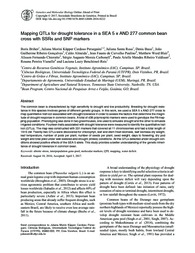Mapping QTLs for drought tolerance in a SEA 5 x AND 277 common bean cross with SSRs and SNP markers.
Mapping QTLs for drought tolerance in a SEA 5 x AND 277 common bean cross with SSRs and SNP markers.
Author(s): BRIÑEZ, B.; PERSEGUINI, J. M. K. C.; ROSA, J. S.; BASSI, D.; GONÇALVES, J. G. R.; ALMEIDA, C.; PAULINO, J. F. de C.; BLAIR, M. W.; CHIORATTO, A. F.; CARBONELL, S. A. M.; VALDISSER, P. A. M. R.; VIANELLO, R. P.; BENCHIMOL-REIS, L. L.
Summary: The common bean is characterized by high sensitivity to drought and low productivity. Breeding for drought resistance in this species involves genes of different genetic groups. In this work, we used a SEA 5 x AND 277 cross to map quantitative trait loci associated with drought tolerance in order to assess the factors that determine the magnitude of drought response in common beans. A total of 438 polymorphic markers were used to genotype the F8 mapping population. Phenotyping was done in two greenhouses, one used to simulate drought and the other to simulate irrigated conditions. Fourteen traits associated with drought tolerance were measured to identify the quantitative trait loci (QTLs). The map was constructed with 331 markers that covered all 11 chromosomes and had a total length of 1515 cM. Twenty-two QTLs were discovered for chlorophyll, leaf and stem fresh biomass, leaf biomass dry weight, leaf temperature, number of pods per plant, number of seeds per plant, seed weight, days to flowering, dry pod weight and total yield under well-watered and drought (stress) conditions. All the QTLs detected under drought conditions showed positive effects of the SEA 5 allele. This study provides a better understanding of the genetic inheritance of drought tolerance in common bean.
Publication year: 2017
Types of publication: Journal article
Unit: Embrapa Rice & Beans
Observation
Some of Embrapa's publications are published as ePub files. To read them, use or download one of the following free software options to your computer or mobile device. Android: Google Play Books; IOS: iBooks; Windows and Linux: Calibre.
Access other publications
Access the Agricultural Research Database (BDPA) to consult Embrapa's full library collection and records.
Visit Embrapa Bookstore to purchase books and other publications sold by Embrapa.

